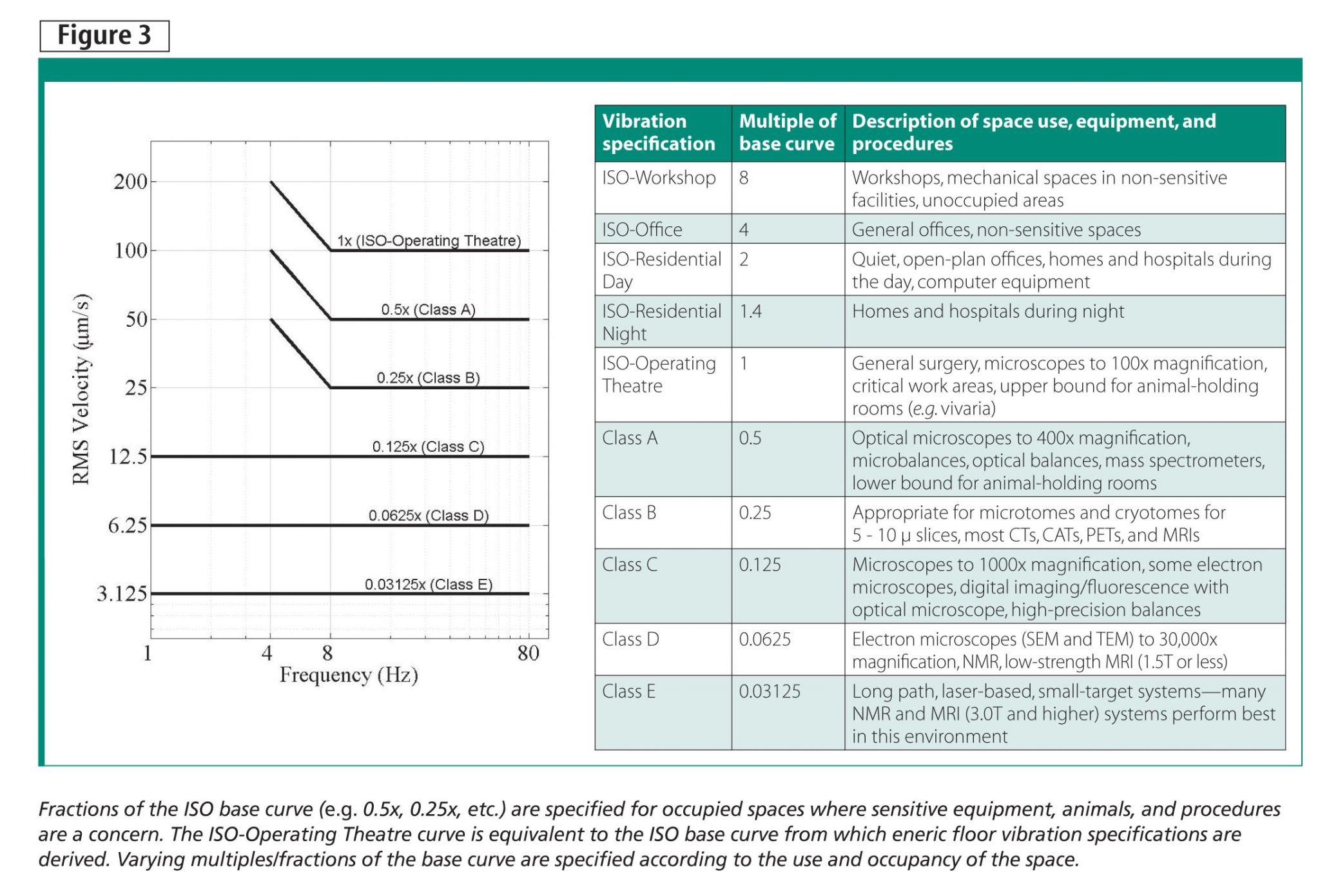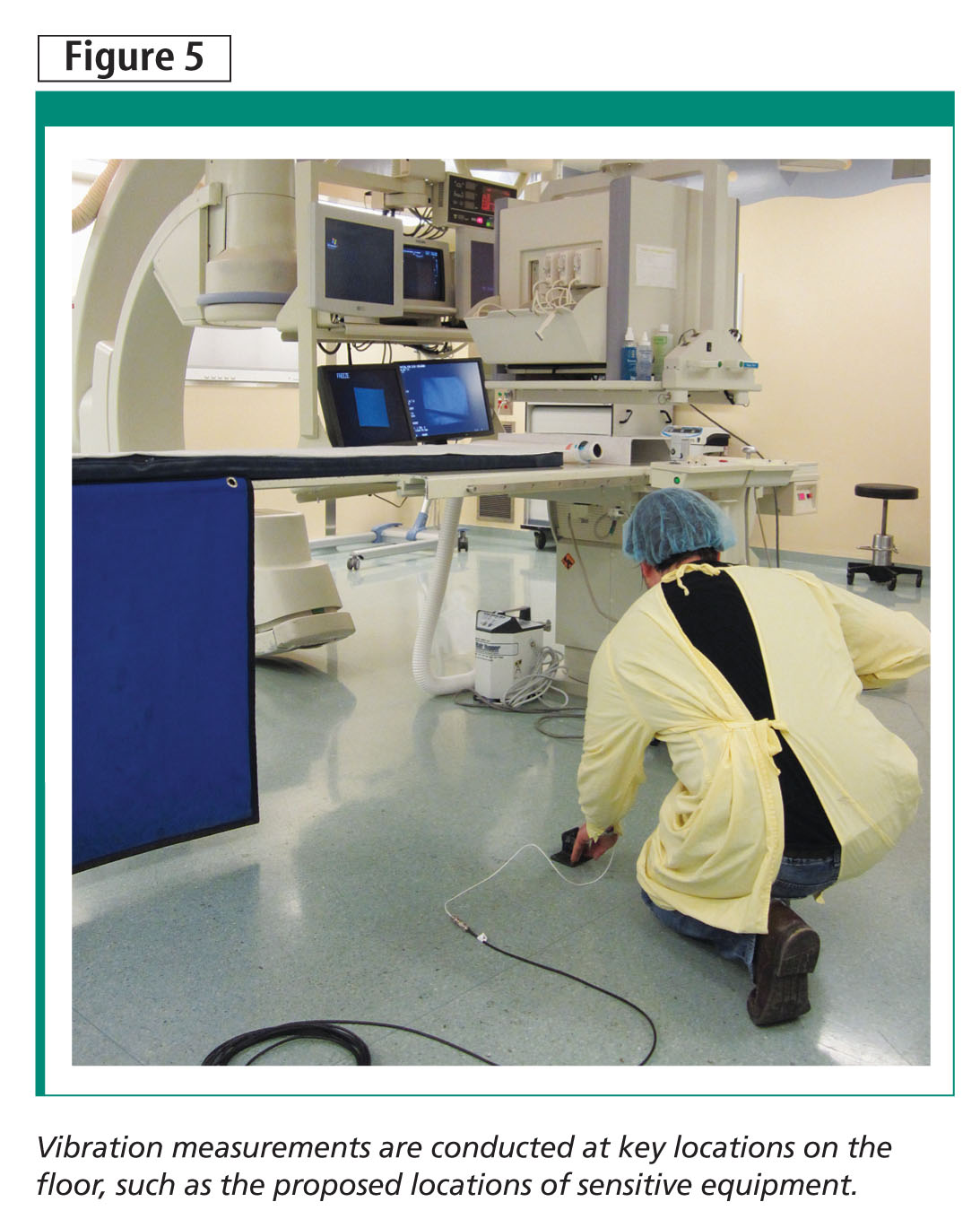Managing floor vibrations in adaptive reuse

By Brad Pridham, PhD, P.Eng.
During a recent visit to the dentist, this author discovered the floor in the waiting area was particularly lively; there were uncomfortable vibrations whenever occupants passed in a nearby corridor. When I mentioned the observation to the hygienist, she responded, “I feel it all of the time while I’m working, and I don’t like it at all. Do you think the floor is safe?”
Architects and engineers understand a structure’s motion of this sort rarely implies danger, but to the uninformed end-user, these perceptible movements are often unexpected and unwelcomed. In the case of this dental office, the prior occupancy was private office space, populated with full-height walls and the heavy furnishings of yesteryear. The space was remodelled to the current open-concept clinic, with low walls in a few areas and less reliance on paper-based storage. The change in layout resulted in a lighter floor live load that has less capability to dampen footfall vibrations.
This example illustrates how the transition of a building space to an occupancy differing from the original design intent—commonly referred to as ‘adaptive reuse’—can result in unforeseen problems related to floor vibrations. These issues can manifest as audible noise and tactile vibration disturbances to occupants, or even reduced functionality for sensitive research or manufacturing and medical equipment. In extreme cases, it can mean onset of damage to architectural and structural elements. Fortunately, many of these problems can be avoided through careful planning and assessment early in the renovation process, ensuring appropriate mitigation is incorporated in the adaptation.
Sources of concern
Floor vibration problems in reuse scenarios are typically caused by:
- occupant activity—walking, running, dancing, and exercising that results in dynamic forces transmitted to the floor during each footfall;
- building services—pumps, fans, and generators with vibrations during operation that can transmit to the structure, resulting in structure-borne noise and tactile levels of vibration; and
- environmental sources—roadway and railway traffic and vibration activity in nearby buildings, which transmit through the ground into the building.
While occupant activity is arguably the most problematic source of vibration on supported floors, it is not uncommon during reuse scenarios for spaces to be sited close to problematic building equipment or exterior roadways, resulting in increased exposure to vibrations from these sources.
Specifying floor vibration requirements
Criteria for floor vibration are specified based on the space’s use and occupancy. Over the past 30 years, researchers and practitioners have developed numerous design and assessment criteria. Many of these evolved from the isoperceptibility curve, which represents the threshold of vibration perception for humans (foot-to-head vibration direction) over the 1 to 80-Hz frequency range.
The y-axis is the root-mean-square (RMS) vibration acceleration level—typically computed for a one-second time window. Floor vibration levels having magnitudes greater than this curve will be perceptible to most people. The flat portion between 4 and 8 Hz represents the frequency range of people’s greatest sensitivity to vibration. The isoperceptibility curve is commonly referred to as the ‘ISO base curve’ because it is defined in International Organization for Standardization (ISO) 2631-1, Mechanical Vibration and Shock–Evaluation of Human Exposure to Whole-body Vibration: Part 1: General Requirements. It serves as the basis for many vibration specifications (Figure 1).
Vibration threshold requirements related to human comfort are specified as multiples of the base curve. Higher multiples of the curve indicates increasing tolerance to vibrations. For example, workshops or mechanical spaces, where occupants generally expect floor vibrations to occur, have higher vibration specifications than office environments (Figure 2).
Floor vibration specifications for spaces housing sensitive equipment, animals, or procedures are commonly expressed in units of RMS velocity (10-9 m/s or µm/s). Similar to the specifications for occupant comfort, the thresholds for sensitive equipment are specified as fractions of the base curve (also referred to as the ISO-Operating Theatre curve in this context, as it is commonly specified for surgical suites).
Each curve is assigned a ‘vibration class,’ representing a category of equipment/procedures appropriate for the specified environment—in other words, vibration levels in the environment should not exceed the assigned threshold. Vibration classes C through E are slight modifications of the base curve, with more stringent requirements at frequencies between 1 and 8 Hz, accounting for the heightened sensitivity of ultra-low vibration equipment in this frequency range (Figure 3).
When specifying vibration criteria, it is important to consider the relationship between the sensitivity of the receiver and the degree of exposure. Human response to vibration is subjective and depends on its duration and the number of occurrences in a given period—collectively, the ‘vibration dosage.’
Although a test or model may produce vibration levels above an appropriate threshold, the events causing this may only occur a small percentage of the time, and result in no complaints. In a recent investigation, office occupants installed their own mitigation on their computer screens by wedging a book or cup underneath to dampen the motions, reducing the discomfort associated with floor vibrations.
When assessing spaces for vibration-sensitive equipment such as imaging (e.g. electron microscopes, MRIs, and NMRs), it is important to consider when the equipment is in operation in relation to when the vibration disturbance occurs (e.g. a train passing on a nearby rail line). It is also important to consider the temporal sensitivity of the instrument—that is, whether it is functionality-sensitive to short impulses versus steady vibrations. Consideration of these issues during planning for reuse can disqualify many vibration sources from being a concern.
As a final note, it is essential space- or equipment-specific criteria be included in the design whenever available. These can often be obtained from equipment manufacturers or through detailed discussions with end users. The criteria discussed here should be used for general assessment and do not incorporate sensitivities such as internal resonances of equipment components. Understanding the space’s requirements is important for specifying appropriate vibration thresholds for the design.
 Identifying the potential for a vibration problem
Identifying the potential for a vibration problem
After a building or space has undergone an adaptive reuse project, the potential for vibration problems is not always obvious. The vibration criteria outlined previously can be used as guidance to identify the relative sensitivity of existing and adapted space configurations. When a lower vibration class than the existing space is required (e.g. a workshop’s conversion into an open-plan office), the potential for vibration problems should be considered. This would include a review of existing and proposed conditions such as the structural system, space layouts, and exposure to vibration sources.
Structural system
The floor system’s ability to accommodate the adaptation from a strength perspective does not necessarily preclude it from being susceptible to vibrations. Lightweight steel framing with long-spans (i.e. typically greater than 8 m [26 ¼ ft]) are more prone, compared to the massive and stiff systems in concrete construction.
Any significant reductions in the superimposed loads following the adaptation will allow the floor to move more when ‘excited’ (i.e. impacted) by footfalls. As such, designers should be particularly concerned when a lightweight floor will become even lighter following adaptation to a space requiring lower vibration thresholds than the existing use and occupancy.
Space layouts
The location and types of partitions and layout of corridors all play important roles in floor vibration performance. Removing partitions spanning mid-bay reduces the mass and damping in the system—this potentially results in increased floor motions. New corridors spanning mid-span areas of the floor can lead to increased vibrations from footfalls, particularly if the bay is shared with a sensitive space. High-traffic corridors in these areas can mean a greater number of disturbances throughout the day (Figure 4).
Exposure to vibration sources
If the adapted space must be located near service rooms, roadways, or rail lines, there is potential for problems. An understanding of the rate of the vibration events’ occurrence and magnitude associated with these sources is helpful for identifying a potential floor problem. Issues related to building equipment can often be mitigated with vibration isolation; however, problems stemming from road and rail traffic are not easily controlled—this may require elaborate structural modifications and isolation systems.
Investigation and assessment
When the potential for a vibration problem has been identified, engineering assessments must quantify impacts and, if necessary, establish control strategies. At minimum, the first step in the process is a site investigation to review the as-built conditions and conduct preliminary measurements.
A cursory review of existing vibration levels, base floor dynamic properties (e.g. frequencies), and as-built structure provides valuable insights regarding possible problems following renovation of the space. It is often beneficial for the vibration consultant to experience firsthand existing floor vibration performance to determine whether the proposed renovation conditions are expected to provide enough mass, damping, and stiffness to suppress unwanted motions (Figure 5).
More extensive testing programs should be undertaken when preliminary measurements indicate a floor vibration problem is likely. As a minimum, measurements of vibration response at key locations on the floor can be conducted to identify sources of concern, characterize problem sources (e.g. frequency of occurrence, magnitudes, frequency content), and extrapolate to expected vibration levels following the adaptation. The data are processed in a manner consistent with the space use—that is, to assess occupant comfort or equipment specifications. This approach is typically all that is required when addressing most floor vibration problems (Figure 6).
A combination of dynamic testing and computer modelling can address more complex cases where extrapolation from measurements is impossible. Testing is used to quantify existing vibration performance, which can then be correlated to computer models for prediction of post-renovation performance and development of control strategies.
Modal testing is a vibration testing technique that determines the dynamic properties of the as-built structure—vibration frequencies, damping levels, and dynamic deflections). Measuring the floor’s response to a known force reveals the correct mass, stiffness, and energy dissipation characteristics. Finite element modelling is used in conjunction with the results from dynamic testing to build a model of the existing floor and simulate the measured responses for validation.
Once an accurate computer model is developed, it can be modified to reflect the renovated conditions and used for simulation studies to predict post-renovation performance. This approach provides the most accurate assessment of floor vibrations, and is frequently used in the automotive and aerospace industries for design development and validation.
Mitigation and control
When detailed assessments indicate unacceptable levels of floor vibration following adaptation, mitigation and control strategies are necessary. Most strategies consist of one or a combination—a successful design balances performance with cost and effects on the facility’s overall function. Relative costs will vary, as solutions are very case-specific.
Operational constraints
When possible, impacts may be controlled through restrictions on the source and/or receiver of vibrations. Examples include restrictions on the operating speed of mechanical equipment, or scheduling vibration-sensitive equipment use during quieter periods (e.g. evenings). This approach is rarely favoured as it has an impact on other aspects of the facility use and functionality, such as costs and energy consumption.
Layout revisions
Changes to the proximity of vibration sources to receiver spaces can improve vibration perception. For example, relocation of high-traffic corridors to stiffer areas of the floor, or relocation of sensitive spaces away from service rooms, can be effective control strategies.
Structural modifications
Strategic revisions to the floor framing can alter the vibration performance, reducing response levels. Examples include reductions in span length by adding support columns and/or adding mass by increasing slab thickness. Depending on existing capacity and the desire for open-plan layouts, however, these modifications may not be possible.
Tuned mass dampers
Secondary systems consisting of springs, mass, and damping elements—tuned mass dampers (TMDs)—are designed to counteract the motion of the floor and introduce damping. By ‘tuning’ the spring and mass to a vibration frequency equal to that of the floor, the motion of the floor causes motion of the TMD, which absorbs vibration energy. These systems are effective at reducing vibrations in the perceptible range and for protecting extreme motions that can lead to structural fatigue (e.g. crowd loads on dance floors).
A limitation of tuned mass dampers can be the amount of mass required for effective performance, which may preclude their use if the floor’s strength capacity is limited. Additionally, the systems themselves require motion to be effective so they are generally ineffective for ultra-low vibration environments (i.e. sub Class A).
Active control
A topic of current research is active control systems, which feature dynamic actuators and moving masses to counteract the floor’s vibration response. They consist of a powered shaker device that, similar to a TMD, moves at a frequency equal to that of the floor, counteracting the motions to reduce floor response.
Although still in development, these systems are showing favourable performance over more traditional control methods as they require significantly less mass. Current limitations include the cost (due to power requirements and fabrication) and maintenance of the systems, which currently preclude their widespread application on some floors. Nevertheless, current research shows promise for effectiveness at floor vibration control.
Receiver isolation
In some cases, it is possible to control the receiver space or equipment using secondary isolation systems, such as isolation pads, platforms, and tables. These are intended to control motion of the receiver, rather than the floor, and are effective when vibration sensitivity is limited to a small area or single equipment toolset. These systems can be costly, but are often a standard feature of ultra-sensitive equipment installations.
Conclusion
Successful management of floor vibrations in adaptive reuse requires an understanding of vibration sensitivity, and careful planning to ensure problems are addressed early in the design stage. A prudent approach is to review the relative sensitivity of the existing and new spaces during the planning phase. A quick discussion with the design team about the structural system, anticipated layouts, and proximity to existing and new sources of vibration is recommended to rule out any concerns related to floor vibrations. It is important to always remember these problems are costly and difficult to fix once a space is furnished and occupied.
 Brad Pridham, PhD, P.Eng., is an acoustics and vibration consultant with Novus Environmental, based in Guelph, Ont. He has spent nine years conducting full-scale and model-scale (wind-tunnel) vibration testing, and developing vibration control strategies for various structures. Pridham’s project experience includes active involvement in building design for healthcare, labs, institutional, education, science and technology, industrial, high-rise residential, and land-use approval. A member of the Society for Experimental Mechanics, his expertise has also been applied to the design of long-span highway and pedestrian bridges, industrial machine installations involving vibration control, and assisting building owners with the solution of wind-induced noise (aeroacoustic) problems associated with architectural façade elements. He can be reached at bradp@novusenv.com.
Brad Pridham, PhD, P.Eng., is an acoustics and vibration consultant with Novus Environmental, based in Guelph, Ont. He has spent nine years conducting full-scale and model-scale (wind-tunnel) vibration testing, and developing vibration control strategies for various structures. Pridham’s project experience includes active involvement in building design for healthcare, labs, institutional, education, science and technology, industrial, high-rise residential, and land-use approval. A member of the Society for Experimental Mechanics, his expertise has also been applied to the design of long-span highway and pedestrian bridges, industrial machine installations involving vibration control, and assisting building owners with the solution of wind-induced noise (aeroacoustic) problems associated with architectural façade elements. He can be reached at bradp@novusenv.com.









